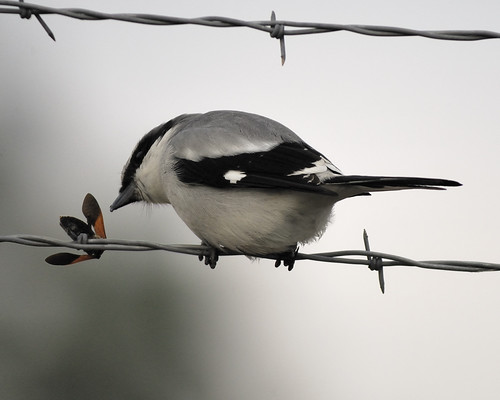tags: Loggerhead Shrike, Lanius ludovicianus, birds, mystery bird, bird ID quiz
[Mystery bird] Loggerhead Shrike, Lanius ludovicianus, inspecting what appears to be a beheaded Black-and-yellow Lichen Moth, Lycomorpha pholus, photographed on the Katy Prairie, Houston, Texas. [I will identify this bird for you in 48 hours]
Image: Joseph Kennedy, 1 January 2010 [larger view].
Nikon D200, Kowa 883 telescope with TSN-PZ camera eyepiece 1/320s f/8.0 at 1000.0mm iso400.
Here's an interesting bird for you to identify, and as an added bonus, can you identify the insect that it is inspecting?
Please name at least one field mark that supports your identification.
- Log in to post comments


Looks like a shrike of some sort (I have no idea which species are in Texas).
Field markings: the black band over its eyes, and what looks like a hooked beak.
Also, it's got a food item impaled on barbed-wire, which is standard behaviour for shrikes, which are also aptly called butcher birds.
What a beautiful shot. Geography pushes one very strongly in a particular direction, and I think the larger version of the shot, especially, lets you see enough detail of the face pattern to eliminate any doubt (if any remained).
That might be enough information for David right there. But if more hints are needed, I'd say that the insect (which I can't identify, not being very far along in my bug education, but I'm guessing it's some kind of wasp or hornet?) is associated with a structure referred to by Sophia Loren in the following quotation: "A woman's dress should be like a [blank]: serving its purpose without obstructing the view."
Also, the scientific name reminds me of a pivotal scene in my favorite Malcolm McDowell movie.
To follow up my own post, after a brief look online for North American shrike distributions I'm going to be more specific and claim it's a Loggerhead Shrike - Lanius ludovicianus.
Ha, got the "barbed wire fence" but I have no idea which movie you might be suggesting- he appeared as a man called Slaughter in an episode of Law & Order (slaughter=butcher?) so if it is in fact a black-masked culprit (which differentiates it from a mockingbird if the thick bill isn't obvious), I think I have it...
Unless, of course, your favorite movie is "A Clockwork Orange", although being a former Marine, I sorta had a little of that so-called "aversion therapy" and like cold showers at certain times, absolutely does not work as advertised!
The insect looks to me like some sort of Tarantula-hawk mimicking sesiid moth. I'm not sure if such a thing exists, though.
Another point in favor of Loggerhead Shrike: The base of the bill is all dark. Also, something I've noticed from photos of these two species over the years: The primary extension on Northerns (which are highly migratory) is longer than on Loggerheads (which show limited migration at most). This bird appears to fit Loggerhead in terms of the primaries.
Unfortunately, I have no idea just how reliable that last point is in the field.
Guessing Loggerhead Shrike. No idea on the insect!
Yeah, Clockwork Orange is what I was going for, as in:
http://en.wikipedia.org/wiki/Ludovico_technique
My other obsession is moths which I regularly trap. I would hazard a guess at Hummingbird Hawk Moth because of the bright orange on the wings and the markings on the abdomen.
Diagnostic features of Loggerhead are the black mask being continuous across the base of the upper mandible, extending above the eye and narrow white supercilium above. The back colour also looks too dark for "excubitor".
Well there's simply no question that this is indeed a Loggerhead Shrike, Lanius ludovicianus: enough of the bill plus the black mask eliminates the Northern Mockingbird, and in addition to a relatively bulky bill, the mask is thick and extends over the eye which eliminates the Northern Shrike, the only other shrike in North America and which I would expect to exhibit slightly darker barring on the underparts and also a bi-colored bill (and which is also well out of range)
With the orange wings and black tips, initially I thought this might even be a beetle from the family Lycidae, the net-winged beetles, but then it occured to me that there is a genus of mimic moths Lycomorpha (five species in the US, 3 found in Texas) that look similar but have the abdominal bulk we can see in the photo, so I'm thinking this might be a beheaded Black-and-yellow Lichen Moth, Lycomorpha pholus.
Are we sure that's not another bug, perhaps a nasal mite sitting on the bill of the shrike?
No idea about the bird, but the bug is a Coreid bug (most likely Leptoglossus sp.) seen from underneath. The wing shape is classic hemipteran (solid top half, membrane lower half) and the color (orange top half, dark below) is characteristic of this genus. The body shape (robust oval - no sag) is unlikely to occur in a moth and the wings rule out beetles. The head appears to have been removed from the insect as the wings articulate at the very anterior of the body.
Compare the body shape and wing color with Leptoglossus occidentalis, and keep in mind your looking from underneath
http://www.forestry.ubc.ca/fetch21/FRST308/lab2/leptoglossus_occidental…
Anax, makes sense to me, although I'm not convinced it is necessarily that genus- thanks!
Just like with other forms of life, we sometimes tend to go straight to "matching" color ahead of systematic keying...
More photos from the family Coreidae
When I was a little kid I went back to the dredge ditch to play and was shocked to see several hatchling garter snakes impaled on barbed wire. I thought that mean older kids had done it. Years later it occurred to me that it'd been the work of a shrike.